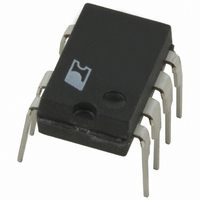TNY268PN Power Integrations, TNY268PN Datasheet - Page 11

TNY268PN
Manufacturer Part Number
TNY268PN
Description
IC OFFLINE SWIT OTP OCP HV 8DIP
Manufacturer
Power Integrations
Series
TinySwitch®-IIr
Specifications of TNY268PN
Output Isolation
Isolated
Frequency Range
124 ~ 140kHz
Voltage - Output
700V
Power (watts)
23W
Operating Temperature
-40°C ~ 150°C
Package / Case
8-DIP (0.300", 7.62mm), 7 Leads
Output Voltage
5.8 V
Input / Supply Voltage (max)
265 VAC
Input / Supply Voltage (min)
85 VAC
Duty Cycle (max)
68 %
Switching Frequency
132 KHz
Supply Current
380 uA
Operating Temperature Range
- 40 C to + 150 C
Mounting Style
Through Hole
Supply Voltage
265VAC
Digital Ic Case Style
DIP
No. Of Pins
8
No. Of Regulated Outputs
1
Filter Terminals
DIP
Rohs Compliant
Yes
On Resistance Rds(on)
5.2ohm
Lead Free Status / RoHS Status
Lead free / RoHS Compliant
Other names
596-1055-5
Available stocks
Company
Part Number
Manufacturer
Quantity
Price
Company:
Part Number:
TNY268PN
Manufacturer:
PowerInt
Quantity:
260 650
Company:
Part Number:
TNY268PN
Manufacturer:
POWER
Quantity:
20 000
Part Number:
TNY268PN
Manufacturer:
POWER
Quantity:
20 000
core size and design (continuous or discontinuous), effi ciency,
minimum specifi ed input voltage, input storage capacitance,
output voltage, output diode forward drop, etc., and can be
different from the values shown in Table 1.
Audible Noise
The TinySwitch-II practically eliminates any transformer audio
noise using simple ordinary varnished transformer construction.
No gluing of the cores is needed. The audio noise reduction is
accomplished by the TinySwitch-II controller reducing the
current limit in discrete steps as the load is reduced. This
minimizes the fl ux density in the transformer when switching at
audio frequencies.
Worst Case EMI & Effi ciency Measurement
Since identical TinySwitch-II supplies may operate at several
different frequencies under the same load and line conditions,
care must be taken to ensure that measurements are made
under worst case conditions. When measuring effi ciency or
EMI verify that the TinySwitch-II is operating at maximum
frequency and that measurements are made at both low and
high line input voltages to ensure the worst case result is
obtained.
Layout
Single Point Grounding
Use a single point ground connection at the SOURCE pin for
the BYPASS pin capacitor and the Input Filter Capacitor
(see Figure 17).
Primary Loop Area
The area of the primary loop that connects the input fi lter
capacitor, transformer primary and TinySwitch-II together
should be kept as small as possible.
Primary Clamp Circuit
A clamp is used to limit peak voltage on the DRAIN pin at turn-
off. This can be achieved by using an RCD clamp (as shown
in Figure 14). A Zener and diode clamp (200 V) across the
primary or a single 550 V Zener clamp from DRAIN to
SOURCE can also be used. In all cases care should be taken
to minimize the circuit path from the clamp components to the
transformer and TinySwitch-II.
Thermal Considerations
Copper underneath the TinySwitch-II acts not only as a single
point ground, but also as a heatsink. The hatched areas
shown in Figure 17 should be maximized for good heat sinking
of TinySwitch-II and the same applies to the output diode.
EN/UV pin
If a line undervoltage detect resistor is used then the resistor
should be mounted as close as possible to the EN/UV pin to
minimize noise pick up.
www.powerint.com
The voltage rating of a resistor should be considered for the
undervoltage detect (Figure 15: R2, R3) resistors. For 1/4 W
resistors, the voltage rating is typically 200 V continuous,
whereas for 1/2 W resistors the rating is typically 400 V
continuous.
Y-Capacitor
The placement of the Y-capacitor should be directly from the
primary bulk capacitor positive rail to the common/return
terminal on the secondary side. Such placement will maximize
the EMI benefi t of the Y-capacitor and avoid problems in
common-mode surge testing.
Optocoupler
It is important to maintain the minimum circuit path from the
optocoupler transistor to the TinySwitch-II EN/UV and
SOURCE pins to minimize noise coupling.
The EN/UV pin connection to the optocoupler should be kept
to an absolute minimum (less than 12.7 mm or 0.5 in.), and
this connection should be kept away from the DRAIN pin
(minimum of 5.1 mm or 0.2 in.).
Output Diode
For best performance, the area of the loop connecting the
secondary winding, the output diode and the output fi lter
capacitor, should be minimized. See Figure 17 for optimized
layout. In addition, suffi cient copper area should be provided
at the anode and cathode terminals of the diode for adequate
heatsinking.
Input and Output Filter Capacitors
There are constrictions in the traces connected to the input
and output fi lter capacitors. These constrictions are present
for two reasons. The fi rst is to force all the high frequency
currents to fl ow through the capacitor (if the trace were wide
then it could fl ow around the capacitor). Secondly, the
Constrictions minimize the heat transferred from the TinySwitch-II
to the input fi lter capacitor and from the secondary diode to
the output fi lter capacitor. The common/return (the negative
output terminal in Figure 17) terminal of the output fi lter
capacitor should be connected with a short, low impedance
path to the secondary winding. In addition, the common/
return output connection should be taken directly from the
secondary winding pin and not from the Y-capacitor
connection point.
PC Board Cleaning
Power Integrations does not recommend the use of “no clean”
fl ux.
For the most up-to-date information visit the PI website
at: www.powerint.com.
TNY263-268
Rev. H 02/09
11












